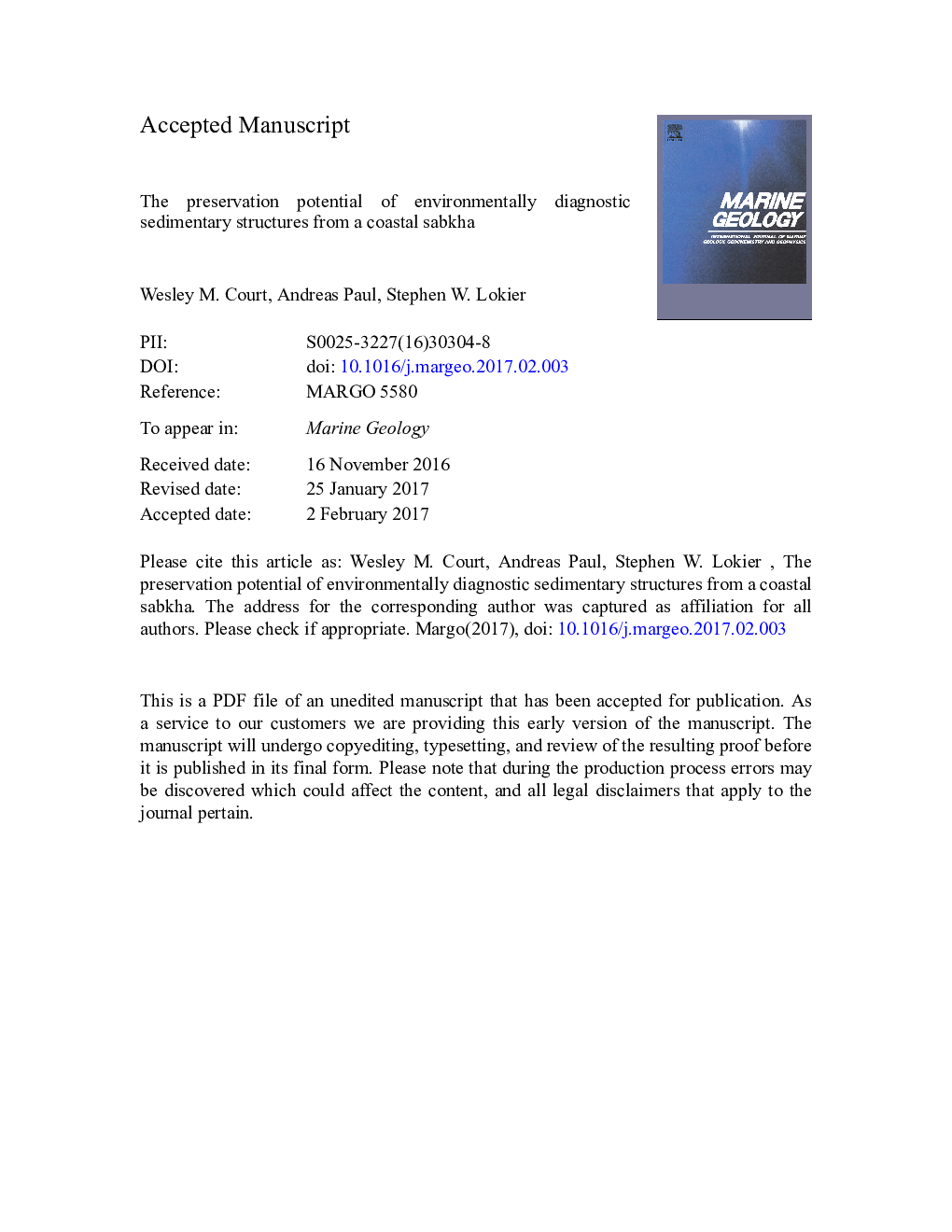| کد مقاله | کد نشریه | سال انتشار | مقاله انگلیسی | نسخه تمام متن |
|---|---|---|---|---|
| 5784508 | 1639066 | 2017 | 56 صفحه PDF | دانلود رایگان |
عنوان انگلیسی مقاله ISI
The preservation potential of environmentally diagnostic sedimentary structures from a coastal sabkha
ترجمه فارسی عنوان
پتانسیل حفظ ساختارهای رسوبی از تشخیص زیست محیطی از یک سابقا ساحلی
دانلود مقاله + سفارش ترجمه
دانلود مقاله ISI انگلیسی
رایگان برای ایرانیان
کلمات کلیدی
ترجمه چکیده
صبحگاه ابوظبی قسمت مرزی رمپ کربناته کم عمق که در سواحل شمال غربی امارات متحده عربی قرار دارد را تشکیل می دهد. سابقا در این منطقه از مجموعه ای پیچیده از رخساره های کربنات، آلی و تبخیری تشکیل شده است که یک توالی صابخا رگرسیونی را تشکیل می دهند. ویژگی های سطح صبحگاه می تواند به ارتباطات متقاطع متقابل پیوسته و پیوسته تقسیم شود که به طور مستقیم با ارتفاع بالاتر از سطح دریا در حال حاضر قابل مقایسه است. تحقیقات پیشین نشان داده است که استخدام سابقاء ابوظبی به عنوان یک آنالوگ جایگزین مدرن برای تشکیلات انفجاری کربنات باستانی است؛ با این حال، تجزیه و تحلیل کمی از رابطه بین سطح صبحگاه و ویژگی های زیرزمینی قبلا انجام نشده است. این مطالعه جزئیات ساختارهای رسوبی و بافت هایی که در سطح سابقا دیده می شود را به تفصیل شرح می دهد و آنها را با رخساره های هولوسن که در زیر سطوح کم عمق حفظ می شود مقایسه می کند. از 36 ساختار رسوبی مشاهده شده در سطح سابقا، تنها هفت (19٪) هنوز در قلمرو زادگاه اولیه شناسایی می شوند. اکثر ساختارهای سطح در طی دفع زودهنگام به علت تجزیه نمک میکروبی، باران ویران مایع و تراکمی از بین رفته است. از دست دادن ویژگی های رسوبی تشخیصی در هنگام دفن زودهنگام به عنوان یک نتیجه از فرایندهای مخرب مواد، پیامدهای قابل ملاحظهای برای شناخت و تفسیر توالی سابقا وجود دارد. مستند سازی این فرایندها از طیف وسیعی از محیط های رسوبی مدرن، در شناسایی ویژگی های تشخیصی که ممکن است به طور قابل اعتماد در بازسازی محیط زیست به کار گرفته شود، کمک می کند.
موضوعات مرتبط
مهندسی و علوم پایه
علوم زمین و سیارات
ژئوشیمی و پترولوژی
چکیده انگلیسی
The Abu Dhabi sabkha constitutes the landward portion of the shallow-sloping carbonate ramp situated on the northwestern coast of the United Arab Emirates (UAE). The sabkha in this region is composed of a complex assortment of carbonate, organic, and evaporitic facies that constitute a regressive sabkha sequence. The surface features of the sabkha can be grouped into distinct, laterally continuous facies associations that are directly correlatable with elevation above present-day sea level. Previous investigations have suggested the employment of the Abu Dhabi sabkha as a modern depositional analogue to ancient carbonate-evaporite formations; however, a quantitative analysis of the relationship between sabkha surface and subsurface characteristics has not previously been undertaken. This study describes in detail the sedimentary structures and textures seen at the sabkha surface and compares them to the Holocene-age facies retained in the shallow subsurface. Of the 36 sedimentary structures observed at the sabkha surface, only seven (19%) are still identifiable in the early burial realm. The majority of the surface structures were lost during early burial as a result of microbial mat decomposition, destructive evaporite precipitation, and compaction. The loss of diagnostic sedimentary features during early burial as a result of fabric-destructive processes has considerable implications for the recognition and interpretation of ancient sabkha sequences. Documenting these processes from a range of modern sedimentary environments will aid in the identification of those diagnostic features that may be reliably employed during paleoenvironmental reconstructions.
ناشر
Database: Elsevier - ScienceDirect (ساینس دایرکت)
Journal: Marine Geology - Volume 386, 1 April 2017, Pages 1-18
Journal: Marine Geology - Volume 386, 1 April 2017, Pages 1-18
نویسندگان
Wesley M. Court, Andreas Paul, Stephen W. Lokier,
